Aperture Functions¶
Aperture functions are used to control the openable proportion of a surface in the Building Simulator based on dynamic factors such as:
Dry bulb temperature (internal & external)
Pollutant levels
External wind speed

There are a number of function string mnemonics which can be used to refer to the different configurations of this dialog.
When scheduling is used in conjunction with automatic control, very complex systems can be created and simulated. The value from the Aperture Schedule (either zero or one) is multiplied with the opening value from the automatic control function. This allows an aperture to be automatically controlled, and available, at only certain times of day.
Each mode can be thought of as a number of ‘rules’ e.g. closing the window above a certain wind speed is a rule in all the modes. Each rule can then be thought of as a function, producing a ‘signal’, a value from zero to one, that indicates whether the window should be open (‘1’) or shut (‘0’).
For example, the wind rule can be represented by this graph:
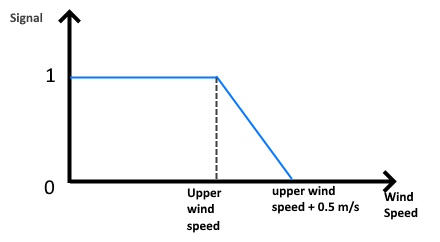
A zone temperature rule could be represented by:
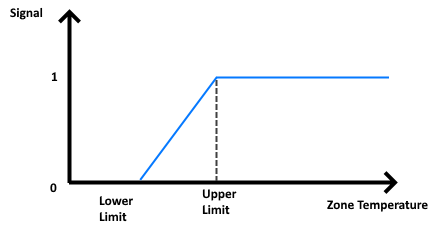
A cut-off rule such as external temperature cut off could be represented by:
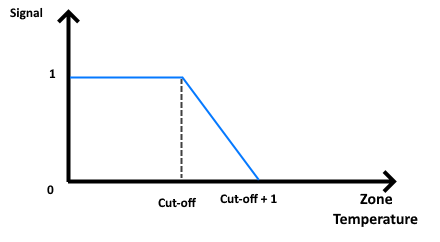
During a simulation, the software will calculate the product of all its rules, and the resulting signal will control the opening proportion of the aperture.
Zone Control¶
This function is used to model mixed mode systems where openings are controlled from the dry bulb temperature of a single zone.
If a mixed mode cut-off is used, the apertures will close when the zone temperature exceeds the cut-off value. This is usually to allow cooling to be introduced via the internal conditions.

Zone¶
The dry bulb temperature of this zone will control the aperture.
Lower Limit¶
The aperture closes when the dry bulb temperature of the zone is below this value.
Upper Limit¶
The aperture will be fully open when the dry bulb temperature of the zone exceeds this value.
Cut-off¶
The aperture will start to close when the dry bulb temperature of the controlling zone rises above this value. The aperture is fully closed when the temperature is 1°C above this value.
Upper wind speed¶
The aperture will start to close when the wind speed exceeds this value. It will be fully closed when the aperture is \(0.5m/s\) above this value.
Example¶
Zone |
East Office |
|---|---|
Lower Limit |
22°C |
Upper Limit |
24°C |
Cut-off |
25°C |
Upper Wind Speed |
5.0 \(m/s\) |
As the dry bulb temperature in zone 5 rose above 22°C the aperture would start to open. The aperture would be fully open at 24°C and remain fully open until 25°C when it would start to close. At 26°C and above the aperture would be closed.
The aperture will also close if, at any time, the outside temperature is greater than the inside temperature. The aperture starts to close when the two temperatures are equal and will be fully closed when the outside temperature is one full degree above inside.
The wind speed will also start to shut the aperture as it increases above 5m/s and be fully closed at 5.5m/s.
Group Peak Temperature Control¶
This function is used to model grouped mixed mode systems, where apertures are controlled from the maximum dry bulb temperature of a group of zones.
The apertures are closed when the maximum group temperature exceeds a cut-off value, so mechanical cooling can be introduced via internal conditions.
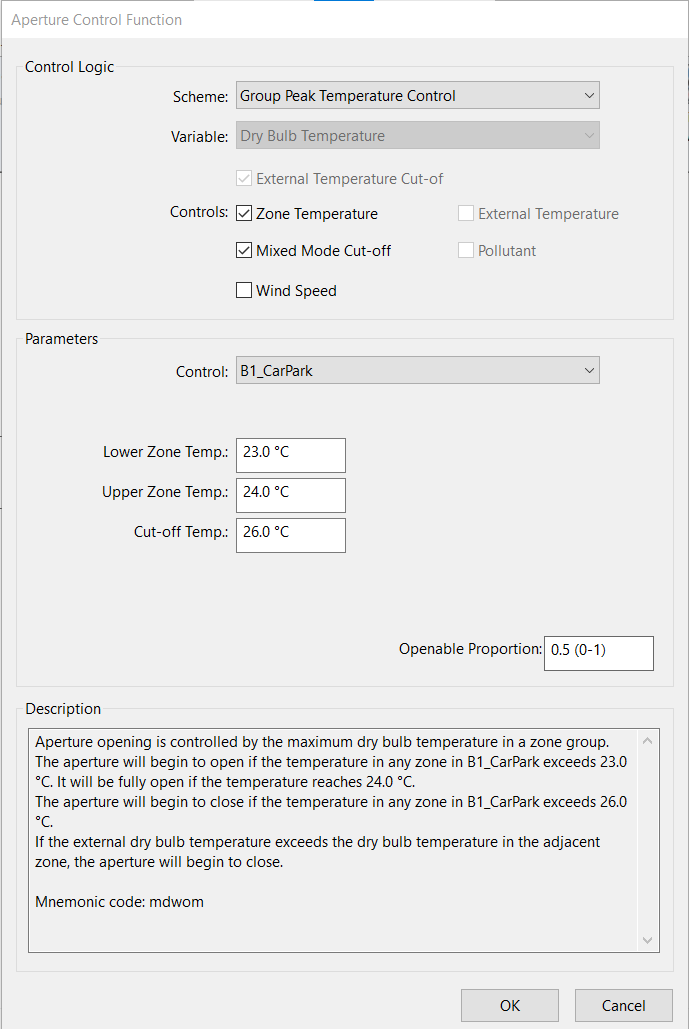
Zone Group¶
The zone with the highest dry bulb temperature within this group will control the aperture.
Lower Limit¶
The aperture will be closed if the dry bulb temperature of the controlling zone is below this value.
Upper Limit¶
The aperture will be fully open if the dry bulb temperature of the controlling zone exceeds this value.
Cut-off¶
The aperture will start to close as the zone with the highest temperature in the control zone group exceeds this temperature. The aperture will be fully closed at 1°C above this value.
Upper wind speed¶
The aperture will will start to close when the wind speed exceeds this value, and will be fully closed when the wind speed is \(0.5m/s\) above this speed.
Example¶
Zone Group |
Offices |
|---|---|
Lower Limit |
22°C |
Upper Limit |
24°C |
Cut-off |
25°C |
Upper Wind Speed |
5.0 \(m/s\) |
As the maximum group temperature in zone group ‘Offices’ rises above 22°C the aperture would start to open. The aperture would be fully open at 24°C and remain fully open until 25°C when it would start to close. At 26°C and above the aperture would be closed.
The aperture will also close if, at any time, the outside temperature is greater than the group maximum temperature. The aperture starts to close when the two temperatures are equal and will be fully closed when the outside temperature is one full degree above inside.
The wind speed will also start to shut the aperture as it increases above 5m/s and be fully closed at 5.5m/s.
Zone Control with Override Zone¶
This function is used to model a system where openings are controlled from the dry bulb temperature of a single zone.
If the dry bulb temperature exceeds the cut-off value, the apertures are closed so mechanical cooling can be introduced via internal conditions.
Additionally, another zone is specified to act as an override control so that if it has a dry bulb temperature greater than the cut-off, the aperture will close.
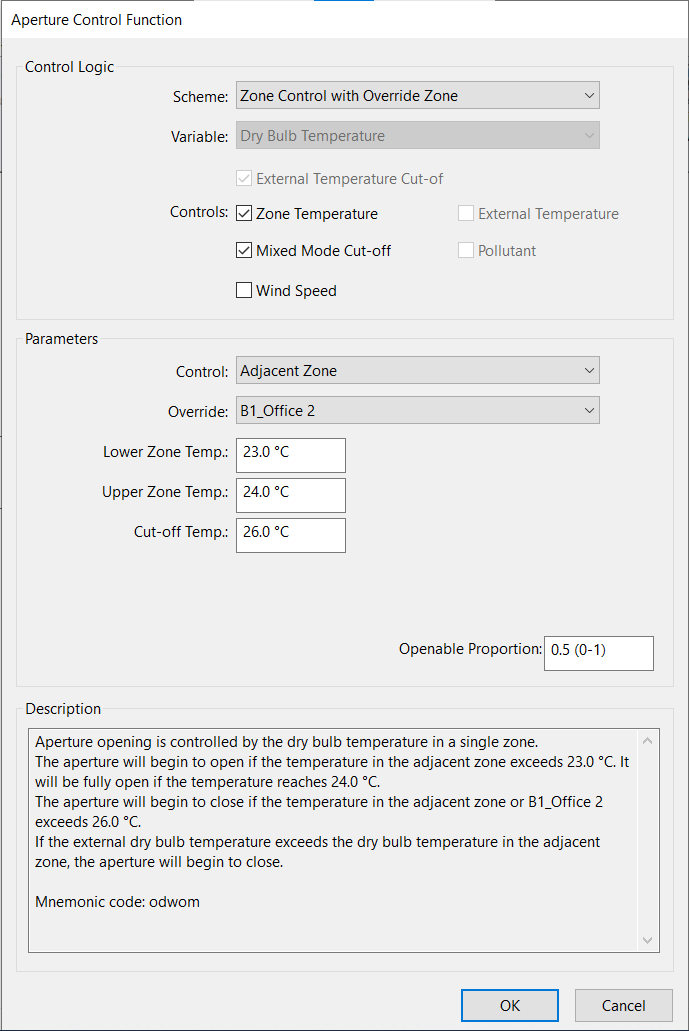
Zone¶
The dry bulb temperature of this zone will control the aperture.
Override Zone¶
The dry bulb temperature of this zone is used as an additional cut-off control.
Lower Limit¶
The aperture will be closed if the dry bulb temperature of the controlling zone is below this value.
Upper Limit¶
The aperture will be fully open if the dry bulb temperature of the controlling zone exceeds this value.
Cut-off¶
The aperture will start to close as the zone with the highest temperature in the control zone group exceeds this temperature. The aperture will be fully closed at 1°C above this value.
Upper wind speed¶
The aperture will will start to close when the wind speed exceeds this value, and will be fully closed when the wind speed is \(0.5m/s\) above this speed.
Example¶
Zone |
East Office |
|---|---|
Lower Limit |
22°C |
Upper Limit |
24°C |
Cut-off |
25°C |
Upper Wind Speed |
5.0 \(m/s\) |
As the dry bulb temperature in ‘East Office’ rose above 22°C the aperture would start to open. The aperture would be fully open at 24°C and remain fully open until 25°C when it would start to close. At 26°C and above the aperture would be closed.
The aperture will also close if, at any time, the outside temperature is greater than the inside temperature. The aperture starts to close when the two temperatures are equal and will be fully closed when the outside temperature is one full degree above inside.
The wind speed will also start to shut the aperture as it increases above 5m/s and be fully closed at 5.5m/s.
Finally, as the dry bulb temperature in ‘West Office’ rises above 25°C the aperture will start to close. When the temperature of ‘West Office’ is above 26°C the aperture will be shut.
Zone Control with Override Group¶
This function is used to model a system where openings are controlled by a single zones dry bulb temperature.
This function can be used to close apertures as the control zones temperature exceeds a certain cut-off value, so mechanical cooling can be introduced via internal conditions.
Additionally, a zone group is specified to act as an override control. If any zone in that group has a dry bulb temperature exceeding the cut-off temperature, the aperture will close.
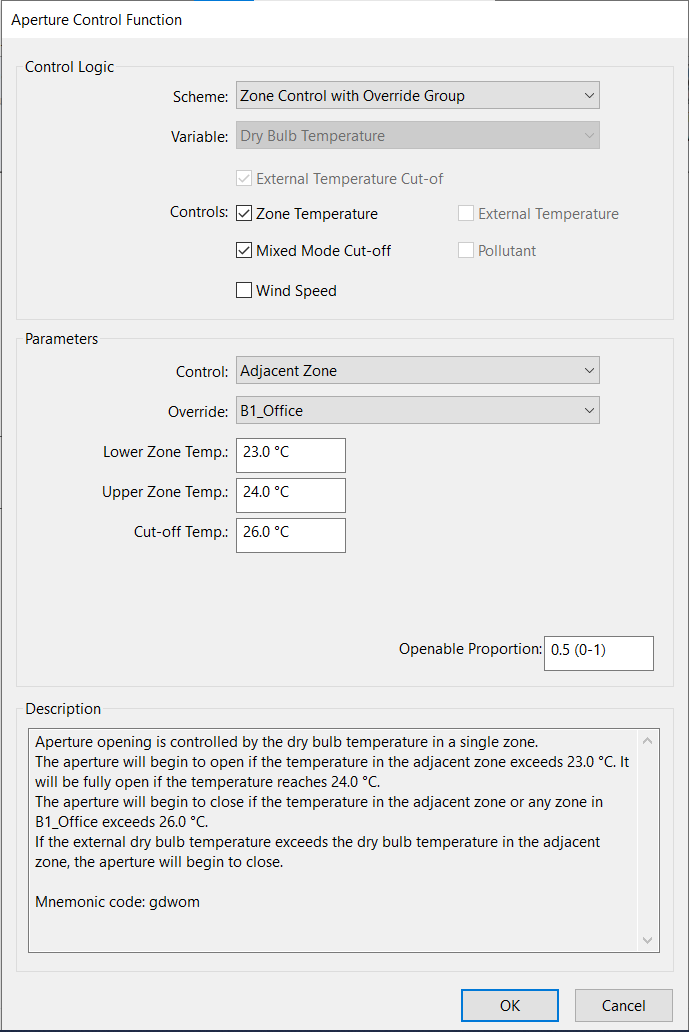
Zone¶
The dry bulb temperature of this zone will control the aperture.
Override Zone Group¶
If any zone within this group has a temperature greater than the cut-off temperature, the aperture is closed.
Lower Limit¶
The aperture closes when the dry bulb temperature of the controlling zone is below this temperature.
Upper Limit¶
The aperture opens when the dry bulb temperature of the controlling zone is above this value.
Cut-off¶
The aperture starts to close when the temperature rises above this value. The aperture is fully closed when the dry bulb temperature is 1°C above this temperature.
Upper wind speed¶
The aperture will start to close when the aperture exceeds this wind speed, and is fully closed at \(0.5m/s\) above this value.
Example¶
Zone |
East Office |
|---|---|
Override Zone Group |
Offices |
Lower Limit |
22°C |
Upper Limit |
24°C |
Cut-off |
25°C |
Upper Wind Speed |
5.0 \(m/s\) |
As the dry bulb temperature in East Office rose above 22°C the aperture would start to open.
The aperture would be fully open at 24°C and remain fully open until 25°C when it would start to close.
At 26°C and above the aperture would be closed.
The aperture will also close if, at any time, the outside temperature is greater than the inside temperature. The aperture starts to close when the two temperatures are equal and will be fully closed when the outside temperature is one full degree above inside.
The wind speed will also start to shut the aperture as it increases above 5m/s and be fully closed at 5.5m/s.
Finally, the ‘Offices’ zone group will be searched for the zone with the highest temperature, then as this temperature rises above 25°C the aperture will start to close. When this zone group maximum temperature is above 26°C the aperture will be shut.
Complex Mixed Mode with Cooling Control¶
This function is used when modelling complex on/off mixed mode systems where openings are controlled from the dry bulb temperature of a single zone, and a zone groups maximum temperature.
The apertures are closed as the zone temperature or group maximum temperature exceeds a cut-off value, so mechanical cooling can be introduced through Internal Conditions.
However, the set point for plant cooling can be below the control range for the aperture thus sending the zones of the zone group into a completely air conditioned state. The control bands overlap only allowing one control to be active at one time, this is achieved as follows.
At the start of each day every active aperture type in this mode has each zone of its zone group flagged as ‘plant inactive’. This ensures that even though the set points in Internal Conditions would indicate that the plant should be on, this is in fact overridden. During the simulation of the day if at any hour the zone exceeds its cut off temperature the aperture type will be flagged as inactive and the plant re-enabled for all the zones in the controlling zone group. This state will continue until the start of the following day when all flags are reset as described earlier. This mode requires the following parameters.
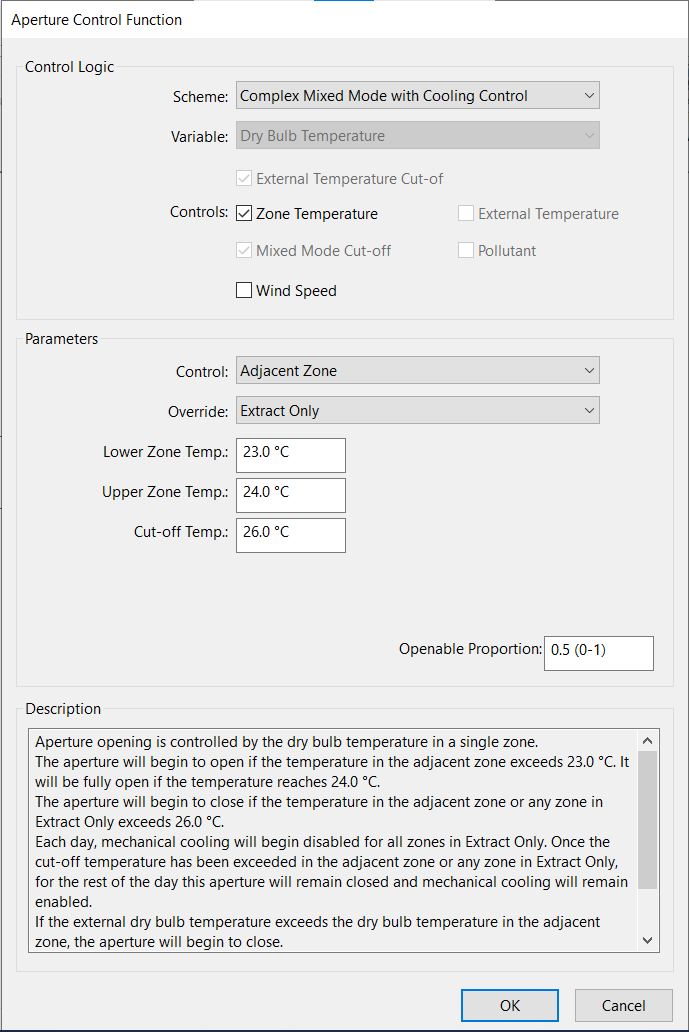
Zone¶
The dry bulb temperature of this zone will control the aperture.
Override Zone Group¶
If any zone within this group has a temperature greater than the cut-off temperature, the aperture is closed.
Lower Limit¶
The aperture closes when the dry bulb temperature of the controlling zone is below this temperature.
Upper Limit¶
The aperture opens when the dry bulb temperature of the controlling zone is above this value.
Cut-off¶
The aperture starts to close when the temperature rises above this value. The aperture is fully closed when the dry bulb temperature is 1°C above this temperature. A/C is then set to active for all zones in the controlling group.
Upper wind speed¶
The aperture will start to close when the aperture exceeds this wind speed, and is fully closed at \(0.5m/s\) above this value.
Example¶
Zone |
East Office |
|---|---|
Override Zone Group |
Offices |
Lower Limit |
22°C |
Upper Limit |
24°C |
Cut-off |
25°C |
Upper Wind Speed |
5.0 \(m/s\) |
As the dry bulb temperature in the east office zone rose above 22°C the aperture would start to open. The aperture would be fully open at 24°C and remain fully open until 25°C when it would shut and the zones in the ‘offices’ zone group would go into full AC mode.
The aperture will also close if, at any time, the outside temperature is greater than the inside temperature. The aperture starts to close when the two temperatures are equal and will be fully closed when the outside temperature is one full degree above inside.
The wind speed will also start to shut the aperture as it increases above 5m/s and be fully closed at 5.5m/s.
Finally, the ‘offices’ zone group will be searched for the zone with the highest temperature. As this highest temperature rises above 25°C the aperture will shut and all zones of the ‘offices# zone group will be placed into full AC mode.